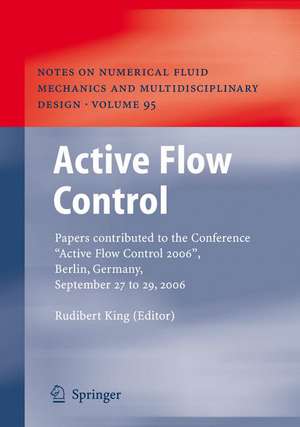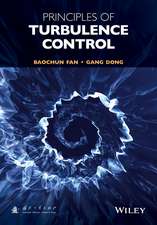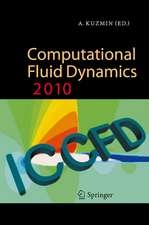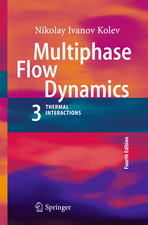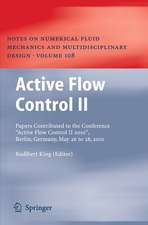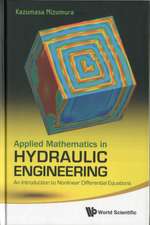Active Flow Control: Papers contributed to the Conference “Active Flow Control 2006”, Berlin, Germany, September 27 to 29, 2006: Notes on Numerical Fluid Mechanics and Multidisciplinary Design, cartea 95
Editat de Rudibert Kingen Limba Engleză Hardback – 31 mai 2007
| Toate formatele și edițiile | Preț | Express |
|---|---|---|
| Paperback (1) | 1224.54 lei 43-57 zile | |
| Springer Berlin, Heidelberg – 23 aug 2016 | 1224.54 lei 43-57 zile | |
| Hardback (1) | 1230.53 lei 43-57 zile | |
| Springer Berlin, Heidelberg – 31 mai 2007 | 1230.53 lei 43-57 zile |
Din seria Notes on Numerical Fluid Mechanics and Multidisciplinary Design
- 18%
 Preț: 1224.36 lei
Preț: 1224.36 lei - 18%
 Preț: 1818.79 lei
Preț: 1818.79 lei - 18%
 Preț: 1115.46 lei
Preț: 1115.46 lei -
 Preț: 413.66 lei
Preț: 413.66 lei -
 Preț: 413.07 lei
Preț: 413.07 lei -
 Preț: 413.84 lei
Preț: 413.84 lei - 18%
 Preț: 1232.26 lei
Preț: 1232.26 lei - 18%
 Preț: 1220.45 lei
Preț: 1220.45 lei - 24%
 Preț: 1044.02 lei
Preț: 1044.02 lei - 18%
 Preț: 1229.91 lei
Preț: 1229.91 lei - 18%
 Preț: 1224.36 lei
Preț: 1224.36 lei - 18%
 Preț: 1215.35 lei
Preț: 1215.35 lei - 18%
 Preț: 1222.80 lei
Preț: 1222.80 lei - 18%
 Preț: 1218.38 lei
Preț: 1218.38 lei - 18%
 Preț: 1223.55 lei
Preț: 1223.55 lei - 18%
 Preț: 1223.55 lei
Preț: 1223.55 lei -
 Preț: 411.93 lei
Preț: 411.93 lei - 18%
 Preț: 1832.22 lei
Preț: 1832.22 lei - 18%
 Preț: 1825.92 lei
Preț: 1825.92 lei - 18%
 Preț: 1225.94 lei
Preț: 1225.94 lei - 18%
 Preț: 1212.53 lei
Preț: 1212.53 lei - 18%
 Preț: 1222.45 lei
Preț: 1222.45 lei - 18%
 Preț: 1830.17 lei
Preț: 1830.17 lei - 18%
 Preț: 948.92 lei
Preț: 948.92 lei -
 Preț: 387.38 lei
Preț: 387.38 lei - 18%
 Preț: 1213.61 lei
Preț: 1213.61 lei - 18%
 Preț: 1243.29 lei
Preț: 1243.29 lei - 18%
 Preț: 952.09 lei
Preț: 952.09 lei
Preț: 1230.53 lei
Preț vechi: 1500.64 lei
-18% Nou
Puncte Express: 1846
Preț estimativ în valută:
235.46€ • 246.50$ • 194.83£
235.46€ • 246.50$ • 194.83£
Carte tipărită la comandă
Livrare economică 07-21 aprilie
Preluare comenzi: 021 569.72.76
Specificații
ISBN-13: 9783540714385
ISBN-10: 3540714383
Pagini: 460
Ilustrații: XIII, 442 p.
Dimensiuni: 155 x 235 x 32 mm
Greutate: 0.81 kg
Ediția:2007
Editura: Springer Berlin, Heidelberg
Colecția Springer
Seria Notes on Numerical Fluid Mechanics and Multidisciplinary Design
Locul publicării:Berlin, Heidelberg, Germany
ISBN-10: 3540714383
Pagini: 460
Ilustrații: XIII, 442 p.
Dimensiuni: 155 x 235 x 32 mm
Greutate: 0.81 kg
Ediția:2007
Editura: Springer Berlin, Heidelberg
Colecția Springer
Seria Notes on Numerical Fluid Mechanics and Multidisciplinary Design
Locul publicării:Berlin, Heidelberg, Germany
Public țintă
ResearchCuprins
The Taming of the Shrew: Why Is It so Difficult to Control Turbulence?.- The Taming of the Shrew: Why Is It so Difficult to Control Turbulence?.- Actuators.- Electromagnetic Control of Separated Flows Using Periodic Excitation with Different Wave Forms.- Pulsed Plasma Actuators for Active Flow Control at MAV Reynolds Numbers.- Experimental and Numerical Investigations of Boundary-Layer Influence Using Plasma-Actuators.- Designing Actuators for Active Separation Control Experiments on High-Lift Configurations.- Closed-Loop Active Flow Control Systems: Actuators.- State Estimation and Feature Extraction.- State Estimation of Transient Flow Fields Using Double Proper Orthogonal Decomposition (DPOD).- A Unified Feature Extraction Architecture.- Air Foils.- Control of Wing Vortices.- Towards Active Control of Leading Edge Stall by Means of Pneumatic Actuators.- Computational Investigation of Separation Control for High-Lift Airfoil Flows.- Steady and Oscillatory Flow Control Tests for Tilt Rotor Aircraft.- Cavities.- Reduced-Order Model-Based Feedback Control of Subsonic Cavity Flows — An Experimental Approach.- Supersonic Cavity Response to Open-Loop Forcing.- Bluff Bodies.- Active Drag Control for a Generic Car Model.- Continuous Mode Interpolation for Control-Oriented Models of Fluid Flow.- Turbomachines and Combustors.- Active Management of Entrainment and Streamwise Vortices in an Incompressible Jet.- Active Control to Improve the Aerodynamic Performance and Reduce the Tip Clearance Noise of Axial Turbomachines with Steady Air Injection into the Tip Clearance Gap.- Optimal Flow Control and Numerical Studies.- Drag Minimization of the Cylinder Wake by Trust-Region Proper Orthogonal Decomposition.- Flow Control on the Basis of a Featflow-Matlab Coupling.- On the Choiceof the Cost Functional for Optimal Vortex Reduction for Instationary Flows.- Flow Control with Regularized State Constraints.- Closed-Loop Flow Control.- Feedback Control Applied to the Bluff Body Wake.- Active Blade Tone Control in Axial Turbomachines by Flow Induced Secondary Sources in the Blade Tip Regime.- Phase-Shift Control of Combustion Instability Using (Combined) Secondary Fuel Injection and Acoustic Forcing.- Vortex Models for Feedback Stabilization of Wake Flows.
Textul de pe ultima copertă
This volume contains a well balanced combination of theoretical and experimental state-of-the-art results of Active Flow Control. It combines new developments in actuator technology, sensing, robust and optimal open- and closed-loop control and model reduction for control. Numerical and experimental applications are considered from aeronautics, turbo-machinery and combustors. The contributions to this book were presented at the conference Active Flow Control 2006, held September 27-29, 2006, at the Technische Universität Berlin, Germany. The conference was organized by the Collaborative Research Center SFB 557 ‘Control of complex turbulent shear flows’, which is funded by the DFG (German Research Foundation).
Caracteristici
State-of-the-art flow control Well balanced combination of theoretical and experimental results Combines new developments in actuator technology, sensing, robust and optimal open- and closed-loop control and model reduction for control
